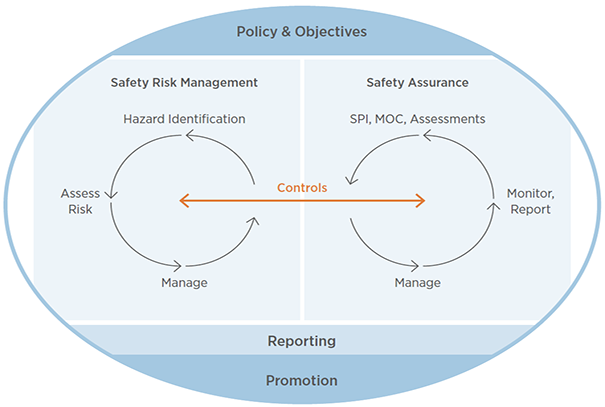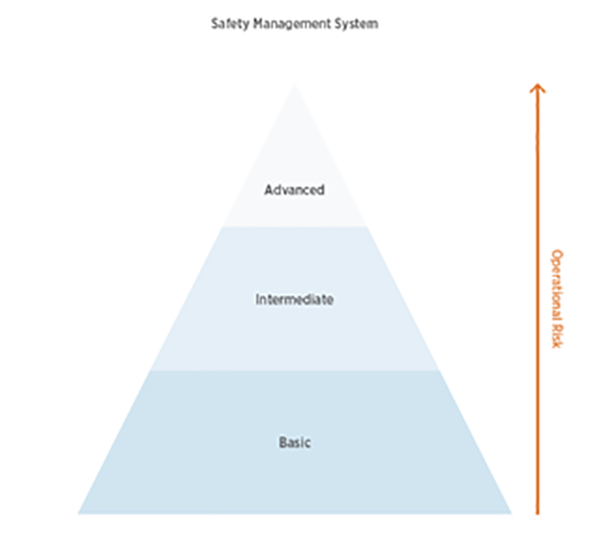
Background
Unmanned Aircraft Systems (UAS) is seen as an exciting new development in the aviation market that has attracted significant investment, with start-ups developing new Electric Vertical Take-off and Landing (eVTOL) design concepts. As with any new market innovation there are significant safety, regulatory and accreditation challenges, and original equipment manufacturers (OEMs), regulators and start-up operators need to work closely together to overcome them.
The travelling public will expect the same safety standards of eVTOL travel that the current aviation industry took decades to achieve. This is a significant challenge considering the timelines proposed for commercial service of UAS & Urban Air Mobility (UAM) aircraft. This article will focus on the Safety Management System (SMS) challenges OEMs and Operators need to prioritise.
Safety Management Manual
The International Civil Aviation Organisation (ICAO) first released guidance on Safety Management Systems through Doc 9859, Safety Management Manual (SMM) in 2006. The 4th edition of the SMM, released in 2018 contains guidance material on safety management principles and concepts, State Safety Programme (SSP) and Safety Management System implementation. All guidance is based upon four components and twelve elements.
Component 1 - Safety Policy

All management systems must define policies, procedures and organisational structures to accomplish the corporate goals.
Component 2 - Safety Risk Management
A formal system of identifying and managing risk is fundamental to controlling risk to acceptable levels. Well-designed risk management within an organisation means understanding operational processes, measuring performance, identifying hazards, and assessing and mitigating risk.
Component 3 - Safety Assurance
Once everything above is in place, the organisation needs to take steps to achieve their safety goals, measure performance and put in place effective risk control processes. They can achieve this through internal audits, investigations, and reporting systems.
Component 4 - Safety Promotion
Safety Promotion is defined as the activities that support the SMS implementation in an organisation, such as training, knowledge sharing, and communication.
UAS Operations
‘Unmanned Aircraft’ means any aircraft operating or designed to operate autonomously or to be piloted remotely without a pilot on board. According to The European Union Aviation Safety Agency (EASA), this definition includes all types of aircraft without a pilot on board, including radio-controlled flying models (powered fixed wing, helicopters, quad/multi-copters, gliders) whether they have an on-board camera or not.
Since unmanned aircraft systems are still a relatively new component of the aviation system, The International Civil Aviation Organization (ICAO), states and the aerospace industry are working to understand, define and ultimately integrate. As the UAS industry has continued to develop, it’s important for the existing ICAO model of SMS to be adapted to uncrewed operations. UAS operations provide a unique set of risk factors that have to be considered. In other words, we must take the existing framework and adapt it to fit evolving needs.
Aircraft operating without a pilot on board presents a wide array of hazards to the civil aviation system. Just as they would with any new airspace redesign, equipment or procedures, operators need to identify these hazards and mitigate the safety risks, so that the aircraft can operate safely in a range of environments.
Michael Huerta, Former Federal Aviation Administration (FAA) administrator stated on 02 August 2016, “We need to incorporate unmanned aircraft and their users into our culture of safety and responsibility. But we need to do it in a way that doesn’t stifle the enthusiasm for this growing industry.”
In the US, the Unmanned Aircraft Safety Team (UAST) formed to address the growing safety needs of UAS operators and manufacturers. UAST is an industry-government partnership committed to ensuring the safe operations of Unmanned Aircraft Systems (UAS) in the US National Airspace System (NAS). The UAST strives to enable the safe integration of UAS by defining consensus-based safety enhancements based on a data-driven process and collaboration amongst members of the UAS industry.
The UAST has identified 3 different levels of operational complexity and risk which will correspond to the type of SMS needed. You can find further details at dronesafetyteam.org.
Choosing the right SMS option
Low Complexity Operations will benefit from a Basic SMS, which can help show the operator how to prepare and act safely.

Medium Complexity Operations will benefit from building on a Basic SMS to establish an Intermediate SMS, which is designed to help standardise safety throughout the operator’s organisation.
High Complexity Operations can benefit from an Advanced SMS that builds on the organisation’s Intermediate SMS and is designed to help a UAS operator continuously improve safety within their organisation.
It’s crucial UAS organisations address all areas of the industry-approved SMS framework. They can achieve this through adaptable SMS components that can be improved and/or modified as the organisation evolves. Risk management practices should also be data driven to allow all stakeholders to understand the acceptable levels of risk.
Measuring performance within safety assurance practices will also help provide a path to continuous improvement. Finally, companies should develop a robust safety culture along with safety promotion activities to support SMS buy in throughout the organisation.
Whilst there are significant challenges still to overcome, this new transport mode is on track to achieve the same safety levels in service as airlines and can provide unsurpassed flexibility in passenger transport, emergency services support and drone delivery services.
This article is part of our Flight Plan series. You can download the latest edition in full via the button below:



